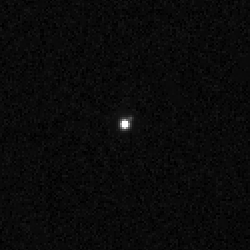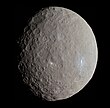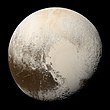
28978 Ixion (, provisional designation 2001 KX76) is a large trans-Neptunian object and a possible dwarf planet. It is located in the Kuiper belt, a region of icy objects orbiting beyond Neptune in the outer Solar System. Ixion is classified as a plutino, a dynamical class of objects in a 2:3 orbital resonance with Neptune. It was discovered in May 2001 by astronomers of the Deep Ecliptic Survey at the Cerro Tololo Inter-American Observatory, and was announced in July 2001. The object is named after the Greek mythological figure Ixion, who was a king of the Lapiths.
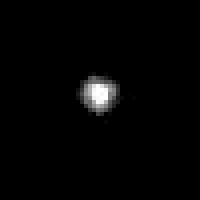
20000 Varuna (provisional designation 2000 WR106) is a large trans-Neptunian object in the Kuiper belt. It was discovered in November 2000 by American astronomer Robert McMillan during a Spacewatch survey at the Kitt Peak National Observatory. It is named after the Hindu deity Varuna, one of the oldest deities mentioned in the Vedic texts.

38628 Huya ( hoo-YAH; provisional designation 2000 EB173) is a binary trans-Neptunian object located in the Kuiper belt, a region of icy objects orbiting beyond Neptune in the outer Solar System. Huya is classified as a plutino, a dynamical class of trans-Neptunian objects with orbits in a 3:2 orbital resonance with Neptune. It was discovered by the Quasar Equatorial Survey Team and was identified by Venezuelan astronomer Ignacio Ferrín in March 2000. It is named after Juyá, the mythological rain god of the Wayuu people native to South America.

(55565) 2002 AW197 (provisional designation 2002 AW197) is a classical, non-resonant trans-Neptunian object from the Kuiper belt in the outermost region of the Solar System, also known as a cubewano. It is the tenth-intrinsically-brightest known trans-Neptunian objct, and with a likely diameter of at least 600 kilometers (400 miles), it is approximately tied with 2002 MS4 and 2013 FY27 (to within measurement uncertainties) as the largest unnamed object in the Solar System. It was discovered at Palomar Observatory in 2002.
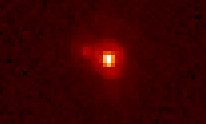
(55637) 2002 UX25 (provisional designation 2002 UX25) is a trans-Neptunian object that orbits the Sun in the Kuiper belt beyond Neptune. It briefly garnered scientific attention when it was found to have an unexpectedly low density of about 0.82 g/cm3. It was discovered on 30 October 2002, by the Spacewatch program; as of August 2024, the object has yet to be named.

(208996) 2003 AZ84 (provisional designation 2003 AZ84) is a trans-Neptunian object with a possible moon located in the outer regions of the Solar System. It is approximately 940 kilometers across its longest axis, as it has an elongated shape. It belongs to the plutinos – a group of minor planets named after its largest member Pluto – as it orbits in a 2:3 resonance with Neptune in the Kuiper belt. It is the third-largest known plutino, after Pluto and Orcus. It was discovered on 13 January 2003, by American astronomers Chad Trujillo and Michael Brown during the NEAT survey using the Samuel Oschin telescope at Palomar Observatory.
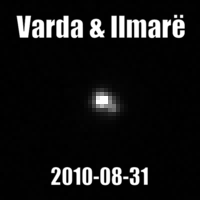
174567 Varda (provisional designation 2003 MW12) is a binary trans-Neptunian planetoid of the resonant hot classical population of the Kuiper belt, located in the outermost region of the Solar System. Its moon, Ilmarë, was discovered in 2009.

(84922) 2003 VS2 is a trans-Neptunian object discovered by the Near Earth Asteroid Tracking program on 14 November 2003. Like Pluto, it is in a 2:3 orbital resonance with Neptune and is thus a plutino. Analysis of light-curve suggests that it is not a dwarf planet.

Salacia is a large trans-Neptunian object (TNO) in the Kuiper belt, approximately 850 km (530 mi) in diameter. It was discovered on 22 September 2004, by American astronomers Henry Roe, Michael Brown and Kristina Barkume at the Palomar Observatory in California, United States. Salacia orbits the Sun at an average distance that is slightly greater than that of Pluto. It was named after the Roman goddess Salacia and has a single known moon, Actaea.
(35671) 1998 SN165 (provisional designation 1998 SN165) is a trans-Neptunian object from the Kuiper belt located in the outermost region of the Solar System. It was discovered on 23 September 1998, by American astronomer Arianna Gleason at the Kitt Peak National Observatory near Tucson, Arizona. The cold classical Kuiper belt object is a dwarf planet candidate, as it measures approximately 400 kilometers (250 miles) in diameter. It has a grey-blue color (BB) and a rotation period of 8.8 hours. As of 2021, it has not been named.

229762 Gǃkúnǁʼhòmdímà (provisional designation 2007 UK126) is a trans-Neptunian object and binary system from the extended scattered disc, located in the outermost region of the Solar System. It was discovered on 19 October 2007 by American astronomers Megan Schwamb, Michael Brown, and David Rabinowitz at the Palomar Observatory in California and measures approximately 600 kilometers (400 miles) in diameter. This medium-sized TNO appears to be representative of a class of mid-sized objects under approximately 1000 km that have not collapsed into fully solid bodies. Its 100-kilometer moon was discovered by Keith Noll, Will Grundy, and colleagues with the Hubble Space Telescope in 2008, and named Gǃòʼé ǃHú.
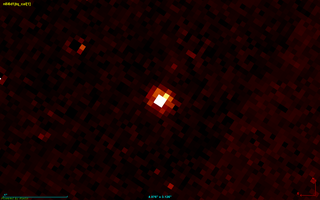
(82075) 2000 YW134 (provisional designation 2000 YW134) is a resonant trans-Neptunian object and binary system, located in the outermost region of the Solar System. It was discovered on 26 December 2000, by astronomers with the Spacewatch survey at Kitt Peak Observatory near Tucson, Arizona. The reddish object stays in a rare 3:8 resonance with Neptune. A smaller companion was discovered by the Hubble Space Telescope in October 2002. As of 2021, neither the primary body nor its satellite have been named.

(386723) 2009 YE7 (provisional designation 2009 YE7) is a trans-Neptunian object (TNO) discovered by David Rabinowitz on December 17, 2009, at the La Silla Observatory in Chile.
(445473) 2010 VZ98 (provisional designation 2010 VZ98) is a trans-Neptunian object of the scattered disc, orbiting the Sun in the outermost region of the Solar System. It has a diameter of approximately 400 kilometers.
(523671) 2013 FZ27 (provisional designation 2013 FZ27) is a trans-Neptunian object located in the Kuiper belt in the outermost region of the Solar System, approximately 570 kilometers (350 miles) in diameter. It was discovered on 16 March 2013, by American astronomers Scott Sheppard and Chad Trujillo at the CTIO in Chile. Numbered in 2018, this minor planet has not been named.

(524366) 2001 XR254, provisional designation 2001 XR254, is a trans-Neptunian object and binary system from the classical Kuiper belt, located in the outermost region of the Solar System. The cubewano belongs to the cold population and measures approximately 171 kilometers (110 miles). It was first observed on 10 December 2001, by astronomers at the Mauna Kea Observatory, Hawaii. Its 140-kilometer sized companion was discovered by the Hubble Space Telescope in June 2006.

(127546) 2002 XU93, provisional designation 2002 XU93, is a trans-Neptunian object and centaur on highly inclined and eccentric orbit in the outer region of the Solar System. It measures approximately 170 kilometers (110 mi) in diameter and is one of few objects with such an unusual orbit. It was discovered on 4 December 2002, by American astronomer Marc Buie at the Kitt Peak National Observatory in Arizona, United States.
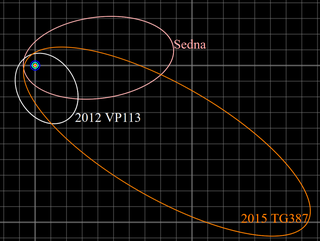
541132 Leleākūhonua (provisional designation 2015 TG387) is an extreme trans-Neptunian object and sednoid in the outermost part of the Solar System. It was first observed on 13 October 2015, by astronomers at the Mauna Kea Observatories, Hawaii. Based on its discovery date near Halloween and the letters in its provisional designation 2015 TG387, the object was informally nicknamed "The Goblin" by its discoverers and later named Leleākūhonua, comparing its orbit to the flight of the Pacific golden plover. It was the third sednoid discovered, after Sedna and 2012 VP113, and measures around 220 kilometers (140 miles) in diameter.

2018 VG18 is a distant trans-Neptunian object (TNO) that was discovered when it was 123 AU (18 billion km; 11 billion mi) from the Sun, more than three times the average distance between the Sun and Pluto. It was discovered on 10 November 2018 by Scott Sheppard, David Tholen, and Chad Trujillo during their search for TNOs whose orbits might be gravitationally influenced by the hypothetical Planet Nine. They announced the discovery of 2018 VG18 on 17 December 2018 and nicknamed the object "Farout" to emphasize its distance from the Sun.
